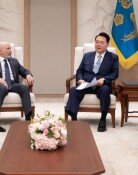Nuclear-powered submarines as a state secret
Nuclear-powered submarines as a state secret
Posted August. 30, 2016 06:59,
Updated August. 30, 2016 07:08
President Park Geun-hye commented Monday on the submarine launched ballistic missile (SLBM) of North Korea and ordered the authorities and military to provide substantial countermeasures against the North’s ever-evolving Nuclear weapons and missile capabilities in her meeting with senior presidential secretaries. With regard to this, nuclear-powered submarines can be the first option of substantial measures President Park stressed.
North Korean leader Kim Jong Un declared that his country is fully equipped with nuclear attack capability after the country successfully test-fired an SLBM. Politicians began to argue the need to introduce nuclear submarines as the launch of SLBM fundamentally changed the geography of security on the Korean Peninsula. A group of 23 the ruling Saenuri lawmakers, headed by former floor leader Won Yoo-chul issued a statement the same day to call for the immediate nuclear-powered submarine deployment to fundamentally contain possible SLBM provocations from the North. Saenuri's incumbent floor leader Chung Jin-suk also asked the military authorities to review special countermeasures including the deployment of nuclear-powered submarines.
The only way to neutralize North Korea’s SLBM force is to track the movement of submarines during a crisis from the moment they leave the base and then carrying out a strike at the crucial moment. Currently the South Korean navy has 15 diesel-electric submarines, including six from the 214-class (1,800-ton) and six from the 209-class (1,200-ton) and it is difficult to engage in underwater military actions for a long-time. Nuclear-powered submarines are necessary for unlimited operations of such kind. By 2020, the navy plans to develop and deploy 3,000-ton submarines in phases under the project titled Jang Bogo III. The timing of constructing and deploying certain number of submarines in the project with nuclear missiles should be advanced as quickly as possible.
In 2003, during the days of former President Roh Moo-hyun’s administration, “362 project,” which was to build three 4,000-ton nuclear-powered submarines, was secretly pushed forward but was later discarded as neighboring states began to notice and reports were released. Comparing the situation with the first nuclear test by the North in 2006, things are getting worse and the deployment of nuclear-powered submarines is more urgently needed. The country is now equipped with much of the technologies to build small nuclear reactors for submarines. Thanks to the nuclear treaty between South Korea and the U.S. revised last year, the enrichment of uranium imported by the U.S. is possible by 20 percent, indicating that the country is allowed to provide nuclear fuel with the consent of the U.S. Some people raise doubt the possibility by arguing Washington concerns that uranium enrichment will ultimately make South Korea to possess nuclear weapons. However, Seoul has to persuade Washington by citing that North Korea’s SLBM can also threat the mainland of the U.S.
As we seen from the controversy surrounding the deployment of the terminal high-altitude area defense (THAAD), the introduction and deployment of nuclear-powered submarines need to be carried out as a state secret. The survival of a nation is in the hands of the deployment of this strategic weapon. Thus, making a public announcement and seeking approvals of neighbors are nothing more than giving up the national security and sovereignty. It’s the time when President Park, who has a solemn duty to maintain the territorial integrity and the continuity of state, must make a prompt decision.
한기흥기자 eligius@donga.com







